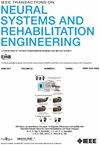利用潜模分析法识别运动性脊髓完全损伤患者幸免的手部运动尺寸和可按比例控制的手部运动尺寸。
IF 4.8
2区 医学
Q2 ENGINEERING, BIOMEDICAL
IEEE Transactions on Neural Systems and Rehabilitation Engineering
Pub Date : 2024-10-03
DOI:10.1109/TNSRE.2024.3472063
引用次数: 0
摘要
双侧手部功能的丧失是数百万脊髓完全运动损伤(SCI)患者所面临的一个令人衰弱的挑战。我们最近在八名四肢瘫痪者身上证明,手部外侧肌肉中存在功能性很强的脊髓运动神经元,它们仍然能够产生成比例的屈伸信号。在这项工作中,我们假设人工智能(AI)系统可以自动学习幸免的肌电图(EMG)模式,这些模式可以编码瘫痪手指的尝试运动。我们限制人工智能以数字手的形式持续输出尝试动作,以便该信号可用于控制任何辅助系统(如外骨骼、电刺激)。我们使用 13 名未受伤(对照组)参与者和 8 名四肢瘫痪参与者(7 名运动完全,1 名运动不完全)的数据训练了一个卷积神经网络,以研究人工智能学习到的潜在空间。我们的模型可以自动区分八种不同的手部动作,包括单个手指的屈伸、抓握和捏合,在 SCI 组中平均准确率达到 98.3%。对模型潜在空间的分析表明,可按比例控制的动作表现出椭圆形轨迹,而缺乏比例控制的动作则表现出混沌轨迹。我们发现,只有当运动的潜空间嵌入遵循椭圆路径时,才能正确估计运动的比例控制(相关性 = 0.73;p < 0.001)。这些发现强调了拟议系统在需要准确估计脊髓运动输出的闭环应用中的可靠性。本文章由计算机程序翻译,如有差异,请以英文原文为准。
Identification of Spared and Proportionally Controllable Hand Motor Dimensions in Motor Complete Spinal Cord Injuries Using Latent Manifold Analysis
The loss of bilateral hand function is a debilitating challenge for millions of individuals that suffered a motor-complete spinal cord injury (SCI). We have recently demonstrated in eight tetraplegic individuals the presence of highly functional spared spinal motor neurons in the extrinsic muscles of the hand that are still capable of generating proportional flexion and extension signals. In this work, we hypothesized that an artificial intelligence (AI) system could automatically learn the spared electromyographic (EMG) patterns that encode the attempted movements of the paralyzed digits. We constrained the AI to continuously output the attempted movements in the form of a digital hand so that this signal could be used to control any assistive system (e.g. exoskeletons, electrical stimulation). We trained a convolutional neural network using data from 13 uninjured (control) participants and 8 tetraplegic participants (7 motor-complete, 1 incomplete) to study the latent space learned by the AI. Our model can automatically differentiate between eight different hand movements, including individual finger flexions, grasps, and pinches, achieving a mean accuracy of 98.3% within the SCI group. Analysis of the latent space of the model revealed that proportionally controllable movements exhibited an elliptical path, while movements lacking proportional control followed a chaotic trajectory. We found that proportional control of a movement can only be correctly estimated if the latent space embedding of the movement follows an elliptical path (correlation =0.73; p <0.001). These findings emphasize the reliability of the proposed system for closed-loop applications that require an accurate estimate of spinal cord motor output.
求助全文
通过发布文献求助,成功后即可免费获取论文全文。
去求助
来源期刊
CiteScore
8.60
自引率
8.20%
发文量
479
审稿时长
6-12 weeks
期刊介绍:
Rehabilitative and neural aspects of biomedical engineering, including functional electrical stimulation, acoustic dynamics, human performance measurement and analysis, nerve stimulation, electromyography, motor control and stimulation; and hardware and software applications for rehabilitation engineering and assistive devices.

 求助内容:
求助内容: 应助结果提醒方式:
应助结果提醒方式:


